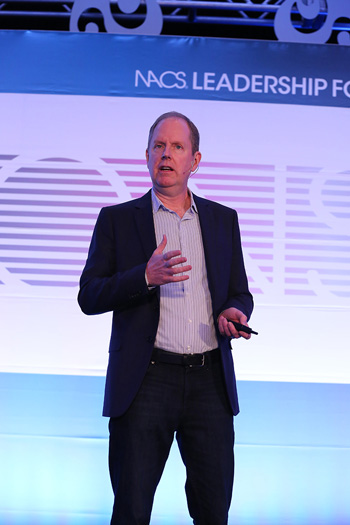MIAMI BEACH, Fla. – Even the most successful companies encounter strategic business challenges, and the convenience and fuel retailing industry is no exception. As businesses strive for growth and increased profits, how they approach and solve operational challenges can produce innovative, business-changing ideas and solutions.
Enter the concept of design thinking, a proven and repeatable problem-solving method that companies rely on to achieve significant results. Design thinking combines creative and critical thinking that allows information and ideas to be organized, decisions to be made, situations to be improved and knowledge to be gained.
Design thinking is a way of using systemic reasoning and intuition to explore and iterate an ideal outcome with the customer in mind—and it’s the focus of the 2017 NACS Leadership Forum taking place this week in Miami Beach. In a series of general sessions, speakers are sharing academic and practical applications of the design-thinking methodology to help industry leaders solve strategic challenges and uncover paths to new business opportunities.
 Author and journalist Warren Berger opened the discussion with a crash-course on design thinking and how it applies to convenience retailing. Berger focused on the basic tool of design thinkers: asking powerful questions that can shift how leaders think about their business. For example, how to better identify and understand stakeholder needs, how to respond to the most common perceptions (and misperceptions) that impact the c-store industry, and how to anticipate what’s next and develop fresh strategies and ideas that take advantage of change.
Author and journalist Warren Berger opened the discussion with a crash-course on design thinking and how it applies to convenience retailing. Berger focused on the basic tool of design thinkers: asking powerful questions that can shift how leaders think about their business. For example, how to better identify and understand stakeholder needs, how to respond to the most common perceptions (and misperceptions) that impact the c-store industry, and how to anticipate what’s next and develop fresh strategies and ideas that take advantage of change.
“Asking [impactful] questions can be very powerful for your business and how you interact with your customers and your employees,” Berger said, noting an example of a powerful, albeit strange, question that led to a product breakthrough most convenience stores sell today.
“Why aren’t the players urinating more?” asked Dwayne Douglas, a University of Florida assistant coach in 1965, when he noticed football players were drinking a lot of water during practice, yet still getting cramps and dehydrated. Douglas took that question to a professor who specialized in renal disease, which led to another important question: What if we developed a product that was better than water at replacing electrolytes? That product, Gatorade, was born.
Business leaders today want answers, not questions. And they want their teams to bring them solutions, not problems. “I’m going to try and convince you that you shouldn’t be saying these things to your employees,” Berger said, adding that the starting point to a big idea or innovation oftentimes begins with a question. “Someone asked a question nobody else was asking,” he said.
So, what makes someone a great questioner, and can you get better at it? Berger cited several examples of great questioners, including Steve Jobs, who was notorious for walking around Apple and questioning why certain process were being done a certain way. There’s also comedian George Carlin, who once asked, “If the black box flight recorder is never damaged in a plane crash, why isn’t the whole damn airplane made out of that stuff?” And then there’s Albert Einstein, who once said that if he had an hour to solve a problem and his life depended on it, he’d spend the first 55 minutes making sure he was solving the right problem.
Jobs, Carlin and Einstein were all great questioners, but Berger said—and backed with research—that the GOAT (greatest of all time) questioners are four-year-old girls.
“Studies show that [a four-year-old] is the ultimate questioning machine,” asking about 300 questions a day, said Berger, noting that we can all release our inner four-year-old and see everything with beginner’s eyes. “You start to ask questions, and maybe you start to ask different questions. Instead of asking how you can do things more efficiently, maybe ask ‘Why are we doing it in the first place?’”
Wrapping back to design thinking, Berger shared that it’s a five-step process: empathize, define, ideate, prototype and test. Through this process, not only will a lot of questions be asked, but it will also create collaboration where answers are found together and not dictated by just one person. And by asking “Why?” you will generate ideas.
And finally, ask authentic questions and don’t be insulting or rhetorical; the key is to be curious.